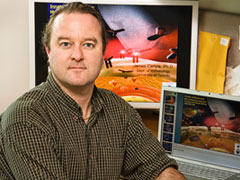Bankrolling Natural Killers
By Laura Pratt
Dr. James Carlyle, a scientist at Sunnybrook Research Institute (SRI), has been awarded an Early Researcher Award by the Ontario Ministry of Research and Innovation. This award, which recognizes young researchers as "rising stars," comprises a grant of $100,000 for his lab over five years.
This financial injection, announced today by Minister of Research and Innovation John Wilkinson, is matched by $50,000 from SRI toward building the scientist's research team. The aim of the program is to ensure leading researchers in Ontario have the resources they need to build research teams comprised of the brightest graduate students, postdoctoral fellows, research assistants and associates from around the world. Carlyle's project is one of 22 that were funded across the Greater Toronto Area.
"The Early Researcher Award will enable me to recruit the top students and postdocs to our team in order to carry out world-class research. For example, I am currently recruiting a postdoctoral fellow from Harvard University who already specializes in a field complementary to my research," says Carlyle.
The Early Researcher Award is a capper to a quartet of funding triumphs Carlyle has enjoyed in recent months.
Along with a second Canadian Institutes of Health Research (CIHR) operating grant (he's three years into his primary CIHR grant from the sponsor, which divides $511,000 over five years), Carlyle was named a co-principal investigator, with a Montreal-based researcher, on a collaborative operating grant for $662,000 over five years.
Carlyle was also named a CIHR New Investigator, which comes with $300,000 for salary support over five years. He ranked number one in his committee in this competition, and in the top 3% overall.
Finally, Carlyle was awarded a five-year $500,000 (US) investigator in the Pathogenesis of Infectious Disease Award from the Burroughs Wellcome Fund. While it's technically an award, this one, says Carlyle, also serves as a grant, funding both salary and operating expenses for his lab.
All told, this windfall of research dollars amounts to funding on three fronts for Carlyle, a new recruit to the discipline of molecular and cellular biology at SRI: provincial, national and international.
"This has been phenomenal and for me and a little unexpected," says Carlyle. "You do your best and apply for as many things as you can, but you never expect to get them all. To get funding on each of three levels makes me feel like I've come full circle."
The interest in his work, Carlyle believes, is partly inspired by an Immunity article he published last spring, in which the culmination of five years of research into the molecular interaction he's identified between natural killer (NK) cells and their targets was detailed across 11 pages.
Having discovered a novel receptor-ligand interaction that facilitates NK recognition of cancerous and virus-infected cells—as distinct from healthy, normal cells—Carlyle will now turn his attention to determining how cellular sensors detect pathogen infection, how pathogens can evade immune recognition and what happens to the immune system in the absence of immunosensory genes. All this, Carlyle points out, is "in an attempt to improve scientists' understanding of human resistance to cancer, infection and transplantation."
Carlyle will apply his new fiscal influx to outfitting his lab such that he feels he can meaningfully see through the faith these funding bodies have put in him. "I am thrilled with these announcements," he says. "But now that we have the funding, we have a duty over the next five years to make the best use of that funding possible. It means that my lab will have to expand and hire some postdoctoral fellows and a technician, and figure out space issues. We'll go through some growing pains. But it's really going to be wonderful."
PDF / View full media release »





